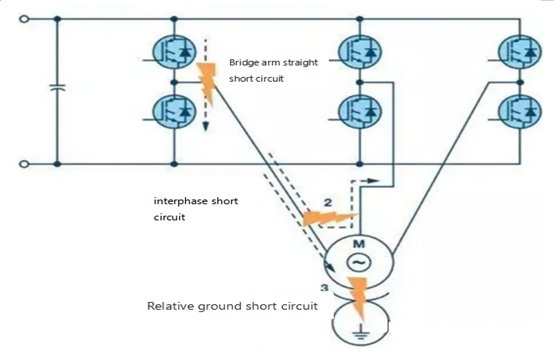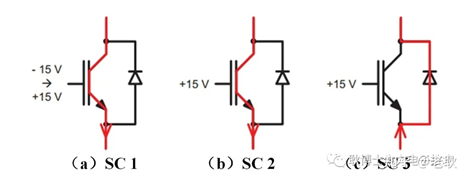What Types Of Short Circuits Are There In IGBT Applications ?
1. Introduction
Overcurrent or short-circuit faults will inevitably occur during the application of IGBTs. When such faults occur, the current of the device will be very large, which will easily increase the junction temperature of the IGBT chip and cause the device to burn out. In order to find out the cause of the fault and find a solution, we generally analyze the fault path when the IGBT is over-current or short-circuited. Let's take the application of two-level inverters as an example to analyze several types of short-circuit faults that are prone to occur in IGBTs, so as to deepen everyone's understanding of short-circuit faults.
2. The difference between IGBT overcurrent and short circuit faults
Before analyzing the short-circuit fault of IGBT, it is necessary to briefly explain the two concepts of over-current and short-circuit.
Overcurrent generally refers to load overload caused by some reason (such as motor stall), and it may also be caused by current divergence and oscillation caused by software control problems. The short circuit generally refers to the direct connection of the bridge arm, or the bus voltage passing through the unloaded circuit of the IGBT (interphase short circuit or relative ground short circuit).
The protection methods of overcurrent and short circuit are also different. The overcurrent protection usually uses the output current sensor as the detection element, and the protection is implemented on the control board through hardware or software, while the short circuit protection can only be detected by hardware, which is generally integrated into the On the IGBT drive circuit, protection is implemented by detecting the desaturation behavior of the IGBT.
Let's take an industrial motor drive inverter as an example to illustrate common short-circuit faults, as shown in Figure 1:

Figure 1 Short-circuit fault of industrial motor drive
① Bridge arm straight-through: two IGBTs of a bridge arm are turned on at the same time. This situation may be due to electromagnetic interference or controller failure, or it may be due to an IGBT failure in the bridge arm, while the normal IGBT keeps switching action.
②Phase-to-phase short circuit: It may be caused by insulation breakdown between motor windings due to performance degradation, overtemperature or overvoltage events, or it may be caused by insulation damage of transmission cables.
③ Phase-to-ground short circuit: It may also be caused by insulation breakdown between the motor winding and the motor casing due to performance degradation, over-temperature or over-voltage events, or it may be due to damage to the transmission cable and grounding.
The above three kinds of faults can all be called short-circuit faults, but the impedance of the short-circuit loop is different. If the output cable of the inverter is long and a short circuit occurs at the end of the cable, the short circuit impedance is relatively large. There may not be much difference between this short circuit and overcurrent, and the short circuit protection can also be carried out by the output current sensor.
It should be noted that the probability of IGBT bridge arm through-short circuit failure is relatively small. Therefore, in some low-cost applications, the IGBT drive circuit does not have integrated short-circuit protection, only over-current protection. At this time, if a short circuit occurs on the load side, whether the device can be kept depends mainly on the impedance of the short circuit loop and the response speed of the current sensor.
3. IGBT short circuit classification
Through the above analysis, you should know the difference between overcurrent and short circuit. Next, we analyze several common short circuit fault types from the perspective of IGBT.

Figure 2 IGBT short-circuit fault types
① IGBT turn-on transient short-circuit behavior (SC 1): short-circuit fault caused by IGBT turn-on (during the process of gate voltage changing from negative voltage to positive voltage), that is, the system does not have a short-circuit fault before the IGBT is turned on.
② Short-circuit behavior during the on-state process of the IGBT (SC 2): During the conduction process of the IGBT (the gate is turned on with a positive voltage) and the forward conduction current, the device current suddenly increases due to external reasons.
③ The short-circuit behavior (SC 3) that occurs during the on-state process of the IGBT. During the conduction process of the IGBT (the gate remains on with a positive voltage), and when the internal freewheeling diode is forward-conducting the current, the device current due to external factors suddenly increase behavior.


